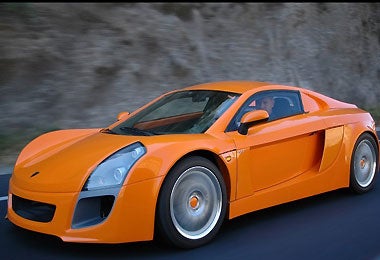Mastretta MTX: Take it to the Mex
Apart from millions of Beetles, Mexico's automotive industry hasn't produced much. But – fasten your seatbelts – here comes the Mastretta MTX. Mark Piesing reports

Some 130 years after the invention of the motor car, two Mexican brothers, Carlos and Daniel Mastretta, are about to make motoring history. In December, at the 2008 International Mexican Auto Show, their £28,000 Mastretta MTX sports car will make its debut as the first ever Mexican-designed and manufactured car. And it's a high-end sports car, very much in the mould of the Lotus Elise.
Not content with a Wikipedia entry, they plan to export their 2.3-litre four- cylinder 200bhp rear-wheel-drive sports car to Europe, Japan and the USA from a purpose-built factory producing 150 cars a year. Exports are essential to ensure a future for the MTX, which features an aluminum chassis and composite body.
Even with help on the car's electronics from Ole Buhl Racing of the UK, this is quite an achievement for the pair of designers, who set up Mastretta back in 1987 to design buses and, er, bottles. It's even more remarkable in a country where many designers feel they have to leave due to a lack of opportunities at home.
Carlos Mastretta admits that it will be quite a challenge to sell a Mexican sports car to the world, even though Mastretta has some automotive "previous" with the 1.6i VW Beetle-based MXA and MXB kit cars it exported to Germany and the US in the 1990s. It has also built replicas of the Porsche Speedster and 1959 Corvette for enthusiasts in the USA and Japan. "We must come up with a great car, not just a good car, as our country has no tradition of sophisticated sports-car manufacturing and our brand is unknown. It must be a car that can make our country, ourselves and our customers happy," Carlos says.
Although the MTX is slightly larger than the Elise, Carlos will be happy if it competes with the Lotus. "Even if the high labour content of a sports car like the MTX gives a Mexican company a cost advantage over its rivals, the challenge will be delivering quality, reliability and performance." The 2004 Elise delivered those in bucketloads, according to the What Car? survey. "But one thing is certain; we will only start selling the car when we are sure the quality is right," says Carlos.
Before the Mastrettas started planning the MTX in 2004, a 1980s model called the Lerma hatchback was closest the Mexican industry has come to a producing a local car since Ford began assembling cars in the country in 1925. That's not a good record for an industry that was exporting 200,000 cars to the USA by 1990, although it is perhaps understandable given the dominance at the time of the US big three – Chrysler, GM and Ford.
Bravely made by the long-defunct government-owned Vehiculos Automotores Mexicanos (VAM) before Renault was paid to take it away and then shut it down, the Lerma was a bolt-together kit of a car made from the Spirit and the Concord – two long-forgotten models by its partner, American Motor Corporation (AMC). VAM also helped to develop the Jeep Cherokee for AMC.
David Leggett, the editor of the motor industry analysis website www.just-auto.com, believes it shouldn't be a surprise that the Mexicans have now produced their own car, as a degree of economic and political "critical mass" has been created in the country. "There is a sense of the Mexicans wanting to take control of their industry and not always be going cap in hand to the big producers. In the past, they have had to claim foreign designs such as the old-style VW Beetle, as theirs just because it was produced for so long in Mexico.
"With an industry churning out two million cars a year, a domestic market worth one million a year, and an economy meshed into a web of free trade agreements coupled with a pool of cheap skilled labour, it's no wonder that niche players such as Mastretta can emerge to claim the flag and make some money," Leggett says.
But even if the economics are right, that doesn't guarantee that the Mastretta MTX will be successful. After all, before Proton of Malaysia took a stake in Lotus, "doing a Lotus" used to mean staggering from crisis to crisis. This might be especially worrying for the Mastrettas as the MTX at the moment has a set of vital statistics that won't be setting any records – 0-60mph in an estimated six or seven seconds and a top speed of 143mph.
The authoritative US industry site Autoblog says the MTX has "the body of a supercar but the performance of a Camry... The MTX's styling may be writing checks that the powertrain can't cash." Even the Spanish-language blog site isidro.ciberblog.es agrees to an extent, describing it as having "figures that are not spectacular but not bad, especially for a company that has no history making this kind of car". The site does, however, pay credit to the car's high level of specification.
Back at HQ in Mexico, Carlos Mastretta has heard the whispers in the blogosphere about the MTX's performance. Even with a 250bhp "track day version" due out in May that could address these issues, the brothers are in last-minute confidential negotiations to give the MTX "a great engine from a great European manufacturer" before the prototype is signed off – an engine that may give the MTX a 0-60mph time of less than six seconds. The bloggers' best guess at the moment is that it will come from Toyota or VW.
Intriguingly, there are reports of a right-hand-drive MTX in the pipeline, and of two requests for distribution rights from British companies.
See the MTX in action by searching for MTX on www.youtube.com
Join our commenting forum
Join thought-provoking conversations, follow other Independent readers and see their replies
Comments
Bookmark popover
Removed from bookmarks